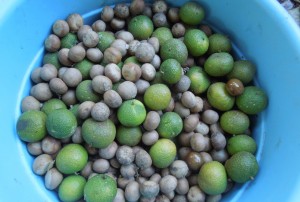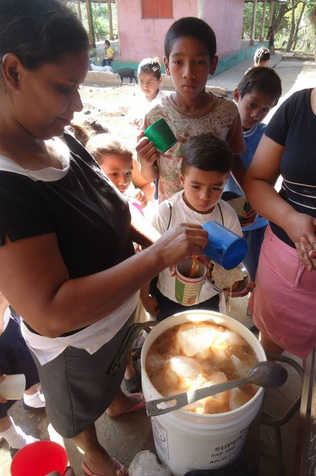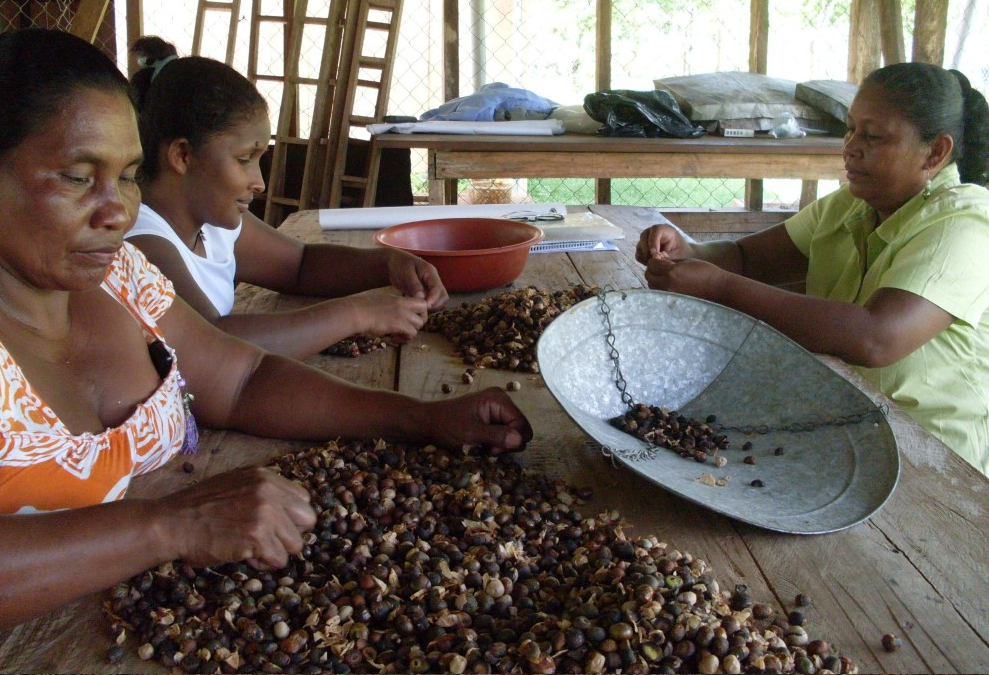Ojoche, Ojite, Ojushte, Ujushte, Capomo, Manchinga, Pisba waihka, Huje, Mojo, Ax, Ramon Nut, Breadnut… a partial list of many names for the same seed. Where I live, Ecuador, it’s called Sande but I had no idea it existed until I heard about the Maya Nut Institute a couple of months ago. Since 2001 Maya Nut Institute has improved livelihoods by empowering women and supporting nutritional health through this amazing seed, which they named “Maya Nut.” Maya Nut Institute is also bringing Maya Nut to the international market by selling it roasted and milled to other companies who incorporate it into different products (from health food stores and healthy coffee initiatives to breweries).
Its many names come from many places; Brosimum alicastrum is found in rainforests across Latin America. Growing up to 50 m in height, all of it – leaves, sap, seed and wood – are used in some way or another across cultures. Sadly though, like me, most people in countries where Brosimum alicastrum is native have largely forgotten about the seed and its use, instead felling the tree for its wood and missing out on Maya Nut, the true treasure.
A superfood nutritionally as well as socially, Canopy Bridge talked to Maya Nut Institute’s founder Erika Vohman, to understand more about the forgotten seed as well as the journey to bring back an ancient food while improving lives across Central America.
“All the animals ate it, and Agustin, my indigenous co-worker, told me he remembered his grandparents eating it in soup,” says Erika when asked how she came to know of Maya Nut. While volunteering in a rainforest animal rescue center in Guatemala back in 1991, she spent a lot of time collecting Maya Nut as feed for the animals. Back in the US she began researching and discovered its forgotten wonders. The journey began.
Among many other claimed medicinal and nutritional properties, Maya Nut is high in fiber, low in fat, and is a potent antioxidant. It also has purportedly miraculous prebiotic effects on the gut. Made simple: it’s great for your digestive system. And since it’s actually a seed, not a true nut, it is a great alternative for those with nut allergies.
 Added to kids lunches as sweet and savory snacks and dishes through the Maya Nut Institute’s “Healthy kids Healthy Forests” Program it has had “dramatic impact on nutritionally compromised kids in as little as two weeks.” This is quite possibly due to its effect on the gut; improving the function of digestive tract can positively impact everything from mood, to immune response, to bone and dental health. The program works to improve nutritional health in impoverished communities in exchange for a commitment to reforest at least 2 hectares with Brosimum alicastrum.
Added to kids lunches as sweet and savory snacks and dishes through the Maya Nut Institute’s “Healthy kids Healthy Forests” Program it has had “dramatic impact on nutritionally compromised kids in as little as two weeks.” This is quite possibly due to its effect on the gut; improving the function of digestive tract can positively impact everything from mood, to immune response, to bone and dental health. The program works to improve nutritional health in impoverished communities in exchange for a commitment to reforest at least 2 hectares with Brosimum alicastrum.
Yet, the benefits of Maya Nut go far beyond its nutritional value. The Institute works training women to collect and process Maya Nut which the Institute then helps sell in international markets. “Maya Nut is an intentionally women branded product” Erika keeps telling me as I ask about the producers and their communities. “It is not that we hate men or don’t want them to participate. I was just really offended by the way women are treated.” The focus on women has yielded successes that after more than a decade of work are palpable, with over 600 women and 25 women-led enterprises in Guatemala, Honduras, El Salvador and Nicaragua. Browsing through Maya Nut producers’ videos the pride and confidence these women exude is clear…empowerment. And by working with women one works with the entire family. By empowering women the family is empowered, forests and children are cared for. “Rural women are so efficient at making something from hardly anything” Erika tells me, explaining how their success is largely due to women’s ability to make resources go a long, long way.
Success has also seen important social change, with men in some communities proud of their empowered, income-generating wives and offering to perform more home chores. “It takes one woman that dares to stand up for herself in order for others to follow and for what we do to succeed.” Even the seemingly simple act of wearing pants by women is a major change; Erika tells me that it’s a symbol that women are daring to stand for themselves and their role as income generators.
Maya nut is still exclusively wild harvested– hard work deep in the forest. And its nutritional and commercial potential is closely bound to the fate of the forests where it was once abundant. Unfortunately, Maya Nut trees are threatened by deforestation and logging for its fine wood and has been red listed as endangered in countries like Bolivia. Creating new value from this forest treasure can contribute to rainforest conservation.
On the market side, the Institute has been successful at pioneering international markets for the seed. With no real previous international trade recorded, the Maya Nut Institute has gone through the lengthy but needed process to set international standards to be able to trade the seed. Moreover, it has generated the Maya Nut Certification to ensure that the product generates real benefits for the women who produce it.
Challenges are still plentiful for the Maya Nut Institute. Erika now works on spreading the word about Maya Nut in an upcoming book about the seed. As I speak to her I can’t help but feel inspired by the social benefits that come from rescuing an ancient superfood, but also by the rescue and revitalization of a cultural and natural gem, another example of our planet’s natural splendor. We’re proud to share the story of Maya Nut Institute and producers like them around the world who are struggling to keep alive a diversity of cultural and natural wealth so that we can live healthier lives.
Thanks to Erika Vohman of the Maya Nut Institute for talking to us in order to write this piece. Check out their profile on CanopyBridge.com or hear from the Maya nut women producers themselves by checking out the multiple videos at http://goo.gl/hLSAHL (Spanish).
***All images by Maya Nut Institute, taken from http://mayanutinstitute.org/
By Karina Bautista – Canopy Bridge




I have to good fortune to have two huge Ramons on my property. I am looking for information on processing the nuts. They can be boiled, roasted or eaten raw. How long to boil? How long to roast at what temperature or what to look for to know they are done? I have done some pruning. Can I use the green nuts? How to process them? It would be great to include this type of information in your pages.